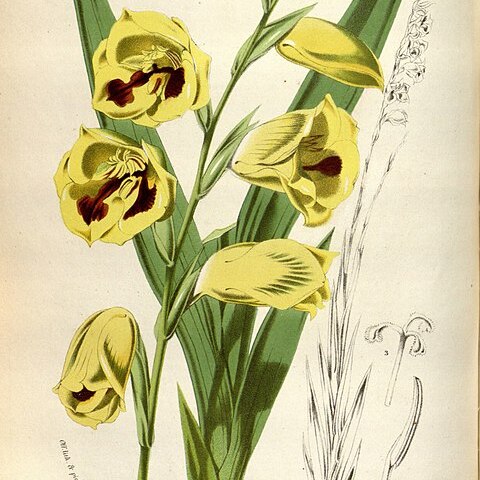Plants (400-)500-750(-1000) mm high. Corm hardly developed at flowering time, rhizome-like, producing slender stolons terminating in a single cormlet; tunics papery-membranous, fragmenting with age. Stem erect or slightly inclined, flexed outward above sheath of uppermost leaf, then inclined, unbranched. Leaves 6 or 7(9), lower 4 to 6 ± basal, reaching to ± middle of stem or above, narrowly lanceolate, 9-14(-19) mm wide, margins and main vein lightly thickened, cauline leaves smaller, largely to entirely sheathing. Spike inclined, usually strongly flexed at base, 4-to 8(-13)-flowered; bracts often flushed grey-purple, outer 20-35 mm long, inner slightly shorter, acute. Flowers nodding, cream-coloured to greenish or yellowish, flushed translucent pink or light purple on inside of upper tepals and greenish to grey or purple on reverse, lower lateral tepals with elongate, dark green or light to dark purple blotches extending into upper part of tube, and with obscure to well-defined crescent-shaped yellow to cream-coloured bands below apices, unscented; perianth tube obliquely funnel-shaped, curving outward at base of upper part, 18-20 mm long, emerging from just above middle of bracts; tepals obovoid, unequal, dorsal largest, 25-35 x 23-30 mm, hooded over stamens, horizontal or tilted toward ground, upper laterals directed forward and contiguous with dorsal and lower tepals to form a wide-mouthed bell, 24-35 x 17-24 mm, lower tepals joined together for ± 2 mm, narrowed below, 22-32 x 14-21 mm, lower median, 20-26 x 13-20 mm. Filaments 20-22 mm long, exserted 7-10 mm from tube; anthers 8-10 mm long, purplish on dorsal surface, cream-coloured below; pollen cream-coloured. Style arching over stamens, dividing opposite upper 1/3 of anthers, branches 4.0-6.5 mm long. Capsules ovate-oblong, 3-lobed above and retuse, 18-24 mm long. Seeds oblong, broadly winged, 8-9 x 4-5 mm, rust-brown.
More
Perennial herb, geophyte, 0.3-1.2 m high; stem erect or inclined, simple. Leaves 6 or 7(-9), lanceolate, 9-14(-19) mm wide, margins and midribs thickened. Bracts green or flushed grey-purple abaxially. Inflorescence a 4-13-flowered spike; flowers nodding, cream-coloured to greenish, upper tepal translucent-pink or light purple inside, greenish to grey or purple on the reverse; perianth tube obliquely funnel-shaped, curving outward above; tepals obovoid, unequal, the dorsal largest, hooded over stamens, horizontal or tilted toward ground; lower tepals joined. Stamens exserted; anthers purplish on dorsal surface, cream-coloured below; pollen cream-coloured. Ovary ovoid; style arching over stamens, branches broader on upper halves. Flowering time Nov.-Mar. Capsule ovate-oblong, 3-lobed; apices retuse.
Cormous geophyte, up to 0.9 m high. Leaves superposed, not forming a fan. Flowers: in a sharply inflexed and strongly inclined, 4-8-flowered spike, 40-55 mm long; bracts 12-40 mm long; anthers 8-10 mm long, purplish or cream-coloured; perianth recurved, nodding, with a short tube and gaping campanulate limb, lower lateral lobes with a oblong dark area, bright to dull yellow or purple with a dark red or purple central band; Dec.-Mar.
Cormous herb, up to 0.9 m high. Perianth curved, nodding, with a short tube and gaping campanulate limb. Lower lateral lobes with an oblong dark area. Flowers bright to dull yellow or purple with a dark red or purple central band.

